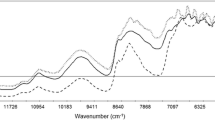Abstract
Purpose
Light-induced fluorescence was evaluated as a process analytical tool in the development of quantitative models for the monitoring of a low-dose formulation manufacturing process.
Method
The system, equipped with a probe, was positioned in a tablet press feed-frame to monitor the active pharmaceutical ingredient content of the flowing powder before compression.
Results
Modeling errors of 1.1% and lower in cross-validation for a 0.67% w/w drug load were observed, which is remarkable for a process analytical tool.
Conclusions
While light-induced fluorescence is emerging as a promising technology, robustness improvements and demonstration of method validation are still required. The technology is expected to become a tool of choice, ready for manufacturing deployment, to support the monitoring and potentially control of low-dose pharmaceutical formulations.






Similar content being viewed by others
References
Duong NH, Arratia P, Muzzio F, Lange A, Timmermans J, Reynolds S. A homogeneity study using NIR spectroscopy: tracking magnesium stearate in Bohle bin-blender. Drug Dev Ind Pharm. 2003;29(6):679–87. https://doi.org/10.1081/DDC-120021317.
Griffen J, Owen A, Matousek P. Comprehensive quantification of tablets with multiple active pharmaceutical ingredients using transmission Raman spectroscopy-a proof of concept study. J Pharm Biomed Anal. 2015;115:277–82. https://doi.org/10.1016/j.jpba.2015.07.019.
Griffen JA, Owen AW, Matousek P. Quantifying low levels (<0.5% w/w) of warfarin sodium salts in oral solid dose forms using transmission Raman spectroscopy. J Pharm Biomed Anal. 2018;155:276–83. https://doi.org/10.1016/j.jpba.2018.04.008.
Li Y, Anderson CA, Drennen JK, Airiau C, Igne B. Method development and validation of an inline process analytical technology method for blend monitoring in the tablet feed frame using Raman spectroscopy. Anal Chem. 2018;90(14):8436–44. https://doi.org/10.1021/acs.analchem.8b01009.
Liu Y, Blackwood D. Sample presentation in rotary tablet press feed frame monitoring by near infrared spectroscopy. American Pharmaceutical Review. 2012.
Ward HW, Blackwood DO, Polizzi M, Clarke H. Monitoring blend potency in a tablet press feed frame using near infrared spectroscopy. J Pharm Biomed Anal. 2013;80:18–23. https://doi.org/10.1016/j.jpba.2013.02.008.
Šašić S, Blackwood D, Liu A, Ward HW, Clarke H. Detailed analysis of the online near-infrared spectra of pharmaceutical blend in a rotary tablet press feed frame. J Pharm Biomed Anal. 2015;103:73–9. https://doi.org/10.1016/j.jpba.2014.11.008.
De Leersnyder F, Peeters E, Djalabi H, Vanhoorne V, Van Snick B, Hong K, et al. Development and validation of an in-line NIR spectroscopic method for continuous blend potency determination in the feed frame of a tablet press. J Pharm Biomed Anal. 2018;151:274–83. https://doi.org/10.1016/j.jpba.2018.01.032.
Li Y, Anderson CA, Drennen JK, Airiau C, Igne B. Development of an in-line near-infrared method for blend content uniformity assessment in a tablet feed frame. Appl Spectrosc 2019:0003702819842189. doi:https://doi.org/10.1177/0003702819842189.
Lai CK, Zahari A, Miller B, Katstra WE, Cima MJ, Cooney CL. Nondestructive and on-line monitoring of tablets using light-induced flourescence technology. AAPS PharmSciTech. 2004;5(1):1.
Dickens JE. Fluorescent sensing and process analytical applications. Process analytical technology: spectroscopic tools and implementation strategies for the chemical and pharmaceutical industries: 2nd edition. 2010. p. 337–52.
Karumanchi V, Taylor MK, Ely KJ, Stagner WC. Monitoring powder blend homogeneity using light-induced fluorescence. AAPS PharmSciTech. 2011;12(4):1031–7. https://doi.org/10.1208/s12249-011-9667-1.
Guay J-M, Lapointe-Garant P-P, Gosselin R, Simard J-S, Abatzoglou N. Development of a multivariate light-induced fluorescence (LIF) PAT tool for in-line quantitative analysis of pharmaceutical granules in a V-blender. Eur J Pharm Biopharm. 2013;86(3):524–31.
Shah IG, Stagner WC. Effect of percent relative humidity, moisture content, and compression force on light-induced fluorescence (LIF) response as a process analytical tool. AAPS PharmSciTech. 2016;17(4):951–7. https://doi.org/10.1208/s12249-015-0420-z.
Author information
Authors and Affiliations
Corresponding author
Ethics declarations
Conflict of Interest
The authors declare that they have no conflict of interest.
Additional information
Publisher’s Note
Springer Nature remains neutral with regard to jurisdictional claims in published maps and institutional affiliations.
Rights and permissions
About this article
Cite this article
Igne, B., Baldasano, C.N. & Airiau, C. Feasibility of Using Light-Induced Fluorescence Spectroscopy for Low-Dose Formulations Monitoring and Control. J Pharm Innov 16, 391–397 (2021). https://doi.org/10.1007/s12247-020-09432-6
Published:
Issue Date:
DOI: https://doi.org/10.1007/s12247-020-09432-6




